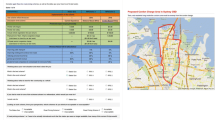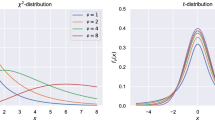Abstract
Latent class models offer an alternative perspective to the popular mixed logit form, replacing the continuous distribution with a discrete distribution in which preference heterogeneity is captured by membership of distinct classes of utility description. Within each class, preference homogeneity is usually assumed, although interactions with observed contextual effects are permissible. A natural extension of the fixed parameter latent class model is a random parameter latent class model which allows for another layer of preference heterogeneity within each class. A further extension is to overlay attribute processing rules such as attribute non-attendance (ANA) and aggregation of common-metric attributes (ACMA). This paper sets out the random parameter latent class model with ANA and ACMA, and illustrates its application using a stated choice data set in the context of car commuters and non-commuters choosing amongst alternative packages of travel times and costs pivoted around a recent trip in Australia. What we find is that for the particular data set analysed, in the presence of attribute processing together with the discrete distributions defined by latent classes, that adding an additional layer of heterogeneity through random parameters within a latent class only very marginally improves on the statistical contribution of the model. Nearly all of the additional fit over the fixed parameter latent class model is added by the account for attribute processing. This is an important finding that might suggest the role that attribute processing rules play in accommodating attribute heterogeneity, and that random parameters within class are essentially a potentially confounding effect. An interesting finding, however, is that the introduction of random parameters increases the probability of membership to full attribute attendance classes, which may suggest that some individuals assign a very low marginal disutility (but not zero) to specific attributes or that there are very small differences in the marginal disutility of common-metric attributes, and this is being accommodated by random parameters, but not observed under a fixed parameter latent class model.


Similar content being viewed by others
Notes
The set of references have papers that impose equality constraints and also papers which relax this condition. There is no de-facto standard practice; for example Hensher and Greene (2010, Table 2) have different parameters across the classes, for each attribute, as do Campbell et al. (2011, Table 1).
Hess et al. (2011) use uncorrelated lognormally distributed random parameters. Collins et al. (2012) use lognormal, constrained triangular and Rayleigh distributions, all uncorrelated. The appeal of these two models is that the imposed restrictions reduce the number of free parameters through constraining the random parameter associated with a specific attribute to be generic across classes. If, however the parameters associated with specific attributes under a specific APR are not independent of the role of the other attributes under consideration within a specific APR, then this may be a limiting condition.
The probabilities are designed and hence exogenously induced to respondents, similar to other travel time variability studies. We acknowledge the contribution of John Rose in the design of the choice experiment.
We removed the employer business sample because we found that it is so different in the way attributes matter, especially costs that are covered by an employer, and this was causing problems in model estimation compared to the remaining data in which the costs are paid for by the respondent.
All models are estimated using Nlogit 5. We investigated unconstrained distributions including lognormal, but models either failed to converge or produced imprecise parameter estimates, most notably on the standard deviations of the random parameters. This is consistent with Collins et al. (2012), who found that constraining the sign of the random parameter distribution is necessary when ANA is handled through latent classes. Literally over 100 h of model estimation time was undertaken in the estimation of the random parameter versions of the models.
We investigated correlations amongst the random parameters in the unconstrained distributions; however such models were an inferior statistical fit over model 4 report in Table 2.
We also ran Model 3 as a standard mixed logit model. Three models were estimated— an unconstrained triangular distribution with and without correlated random parameters, and a constrained triangular distribution that does not permit correlated parameters. The respective log-likelihoods (and AIC) at convergence were −5512.22 (1.176), −5568.57 (1.187) and −6158.89 (1.311). In all cases these models are inferior, statistically, to Models 1–4 in Table 2, although an expected improvement over multinomial logit (−6729.90, 1.433). Given that Model 4 outperforms the standard mixed logit model, then Model 4 is additionally an improvement over a model with preference heterogeneity accommodated with continuous random taste heterogeneity (as opposed to the Model 1 with discrete preference heterogeneity).
Noting that in all of the estimated models, we have preference heterogeneity of some kind, whether discrete or continuous.
We are aware of only two studies that have estimated random parameter latent class models allowing for ANA (Hess et al. 2011; Collins et al. 2012). They are not directly comparable with the current study because they do not allow for ACMA and multiple FAA classes, using instead a single FAA class. The main finding, however, of both of these studies is that the inclusion of random parameters and ANA does improve the model fit. There is thus a consistent message under different assumptions re the role of random parameters. Studies that introduce random parameters into latent class models without attribute processing are Greene and Hensher (2013) who found clear improvement with random parameters added to a LCM; Bujosa et al. (2010) who also found an found improvement, albeit with the random parameters making only a small contribution (in line with only a small improvement of a RPL model over the MNL), and Vij (2012) who does not report the LCM without random parameters, so a comparison cannot be made.
References
Bujosa, A., Riera, A., Hicks, R.: Combining discrete and continuous representation of preference heterogeneity: a latent class approach. Environ. Resour. Econ. 47, 477–493 (2010)
Campbell, D., Hensher, D.A., Scarpa, R.: Non-attendance to attributes in environmental choice analysis: a latent class specification. J. Environ. Plan. Manag. 54(8), 1061–1076 (2011)
Campbell, D., Hutchinson, W., Scarpa, R.: Incorporating discontinuous preferences into the analysis of discrete choice experiments. Environ. Resour. Econ. 41(3), 401–417 (2008)
Carlsson, F., Kataria, M., Lampi, E.: Dealing with ignored attributes in choice experiments on valuation of Sweden. Environ. Resour. Econ. 47(1), 65–89 (2010)
Collins, A.T., Rose, J.M., and Hensher, D.A.: The random parameters attribute nonattendance model. Paper presented at The 13th International Conference on Travel Behaviour Research, Toronto, July (2012)
Everitt, B.: A finite mixture model for the clustering of mixed-mode data. Stat. Probab. Lett. 6, 305–309 (1988)
Fiebig, D., Keane, M., Louviere, J., Wasi, N.: The generalized multinomial logit: accounting for scale and coefficient heterogeneity. Mark. Sci. 29(3), 393–421 (2010)
Greene, W.H., Hensher, D.A.: A latest class model for discrete choice analysis: contrasts with mixed logit. Transp. Res. Part B 37, 681–698 (2003)
Greene, W.H., Hensher, D.A.: Does scale heterogeneity matter? a comparative assessment of logit models. Transportation 37(3), 413–428 (2010)
Greene, W.H., Hensher, D.A.: Revealing additional dimensions of preference heterogeneity in a latent class mixed multinomial logit model. Appl. Econ. 45(14), 1897–1902 (2013)
Heckman, J., Singer, B.: A method for minimizing the impact of distributional assumptions in econometric models. Econometrica 52, 271–320 (1984)
Hensher, D.A.: How do respondents process stated choice experiments? Attribute consideration under varying information load. J. Appl. Econ. 21(6), 861–878 (2006)
Hensher, D.A., Greene, W.H.: Non-attendance and dual processing of common-metric attributes in choice analysis: a latent class specification. Empir. Econ. 39(2), 413–426 (2010)
Hensher, D.A., Rose, J.M.: Simplifying choice through attribute preservation or non-attendance: implications for willingness to pay. Transp. Res. Part E 45(4), 583–590 (2009)
Hensher, D.A., Rose, J.M., Greene, W.H.: The implications on willingness to pay of respondents ignoring specific attributes. Transportation 32, 203–222 (2005)
Hensher, D.A., Li, Z., and Rose, J.M.: Accommodating risk in the valuation of expected travel time savings. J. Adv. Transp. online 16 January 2011 (2012a). doi:10.1002/atr.160
Hensher, D.A., Rose, J.M., Greene, W.H.: Inferring attribute non-attendance from stated choice data: implications for willingness to pay estimates and a warning for stated choice experiment design. Transportation 39(2), 235–246 (2012)
Hess, S., Hensher, D.A.: Using conditioning on observed choices to retrieve individual-specific attribute processing strategies. Transp. Res. Part B 44(6), 781–790 (2010)
Hess, S., Rose, J.M.: A latent class approach to modelling heterogeneous information processing strategies in SP studies. Paper presented at the Oslo Workshop on valuation methods in transport planning, Oslo (2007)
Hess, S., Stathopoulos, A., Campbell, D., O’Neill, V., Caussade, S.: It’s not that I don’t care, I just don’t care very much: confounding between attribute non-attendance and taste heterogeneity. Transportation (2011). doi:10.1007/s11116-012-9438-1
Hess, S., Stathopoulos, A., Daly, A.: Allowing for heterogeneous decision rules in discrete choice models: an approach and four case studies. Transportation 39(3), 565–591 (2012)
Hole, A.R.: A discrete choice model with endogenous attribute attendance. Econ. Lett. 110(3), 203–205 (2011)
Layton, D., Hensher, D.A.: Aggregation of common-metric attributes in preference revelation in choice experiments and implications for willingness to pay. Transp. Res. Part D 15, 394–404 (2010)
Li, Z., Hensher, D.A., Rose, J.M.: Willingness to pay for travel time reliability for passenger transport: a review and some new empirical evidence. Transp. Res. Part E. 46(3), 384–403 (2010)
McNair, B., Hensher, D.A., Bennett, J.: Modelling heterogeneity in response behaviour towards a sequence of discrete choice questions: a probabilistic decision process model. Environ. Resour. Econ. 51, 599–616 (2012)
Puckett, S.M., Hensher, D.A.: The role of attribute processing strategies in estimating the preferences of road freight stakeholders under variable road user charges. Transp. Res. E 44, 379–395 (2008)
Rose, J.M., Bliemer, M.C., Hensher, D.A., Collins, A.T.: Designing efficient stated choice experiments in the presence of reference alternatives. Transp. Res. B 42(4), 395–406 (2008)
Scarpa, R., Gilbride, T.J., Campbell, D., Hensher, D.A.: Modelling attribute non-attendance in choice experiments for rural landscape valuation. Eur. Rev. Agric. Econ. 36(2), 151–174 (2009)
Scarpa, R., Thiene, M., Hensher, D.A.: Monitoring choice task attribute attendance in nonmarket valuation of multiple park management services: does it matter? Land Econ. 86(4), 817–839 (2010)
Shen, J.: Latent class model or mixed logit model? A comparison by transport mode choice data. Appl. Econ. 41, 2915–2924 (2009)
Thiene, M., Meyerhoff, J., De Salvo, M.: Scale and taste heterogeneity for forest biodiversity: models of serial nonparticipation and their effects. J. For. Econ. 18(4), 355–369 (2012)
Train, K.: EM algorithms for nonparametric estimation of mixing distributions. J. Choice Model. 1(1), 40–69 (2008)
Train, K., Weeks, M.: Discrete choice models in preference space and willing to-pay space. In: Scarpa, R., Alberini, A. (eds.) Applications of Simulation Methods in Environmental and Resource Economics, chapter 1, pp. 1–16. Springer Publisher, Dordrecht, (2005)
Wasi, N., Carson, R.T.: The Influence of Rebate Programs on the Demand for Water Heaters The Case of New South Wales. UC Center for Energy and Environmental Economics, Berkeley (2011)
Vij, A., Carrel, A., Walker, J.L.: Latent modal preferences: behavioral mixture models with longitudinal data, E3 WP-025, UC Berkeley, Department of Civil and Environmental Engineering, Berkeley (2012)
Acknowledgments
We thank the three referees for their extensive comments, which have resulted in major revisions and new models.
Author information
Authors and Affiliations
Corresponding author
Rights and permissions
About this article
Cite this article
Hensher, D.A., Collins, A.T. & Greene, W.H. Accounting for attribute non-attendance and common-metric aggregation in a probabilistic decision process mixed multinomial logit model: a warning on potential confounding. Transportation 40, 1003–1020 (2013). https://doi.org/10.1007/s11116-012-9447-0
Published:
Issue Date:
DOI: https://doi.org/10.1007/s11116-012-9447-0




